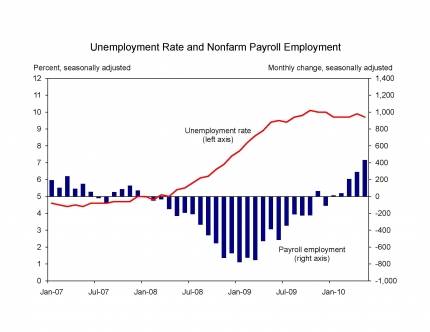Unemployment Remains in a State of Crisis
The May jobs number is out, and at first blush it looks good. The economy added 431,000 jobs in May and the unemployment rate tracked down to 9.7 percent. But
Jul 31, 2020864.9K Shares12.9M Views
The May jobs numberis out, and at first blush it looks good. The economy added 431,000 jobs in May and the unemployment rate tracked down to 9.7 percent. But the report, in reality, is terrible, another sign of the long-standing crisis of joblessness in the United States. Economists were hopingthat the private sector would add between 100,000 and 200,000 jobs. But private employers expanded their payrolls by a measly 41,000 positions. That is simply not enough: The United States needs to add 100,000 to 150,000 jobs a month just to keep pacewith population growth, and jobs need to grow a lot faster than that to make a dent in the headline unemployment rate. Fifteen million Americans are unemployed, several million of whom have been out of work for more than six months and more than one million of whom have been out of work for two years. Again, crisis is the appropriate word.
Politicians might try to spin this. This morning Christina Romer, the head of the administration’s Council of Economic Advisers, wrote on the White House blogthat today’s report “shows continued signs of labor market recovery.” She posted this chart, where the trends do look good. But if you take that right-most blue bar — which shows job growth — and take out the temporary census jobs, it’s barely existent. And once the census is over, those jobs are gone.
Washington has not run out of options to tackle the unemployment crisis. The government could expand, directly hiring workers. (As the census demonstrates, when the government hires workers, unemployment goes down.) It could push tax incentives and stimulus, so that Americans spend more and companies decide to hire more workers. It could take up Rep. George Miller’s (D-Calif.) Local Jobs for America Act, providing $75 billion to local governments to keep employees on the payroll. Or it could have considered Sen. Tom Harkin’s (D-Iowa) proposalto grant $23 billion to keep public school teachers in their classrooms, the Keep Our Educators Working Act. Both of those bills would have preserved or created local government jobs, and a spate of other congressional initiatives are aimed at private-sector hiring.
But the issue at this point is not ideas, but will. Congress has simply lost its appetite for expensive job-saving or job-creating programs given the deficit. That does not mean the economy won’t recover. It will. But it means that unemployment will continue to lag behind the recovery, sustaining severe hardship for families and individuals.

Paolo Reyna
Reviewer
Paolo Reyna is a writer and storyteller with a wide range of interests. He graduated from New York University with a Bachelor of Arts in Journalism and Media Studies.
Paolo enjoys writing about celebrity culture, gaming, visual arts, and events. He has a keen eye for trends in popular culture and an enthusiasm for exploring new ideas. Paolo's writing aims to inform and entertain while providing fresh perspectives on the topics that interest him most.
In his free time, he loves to travel, watch films, read books, and socialize with friends.
Latest Articles
Popular Articles
